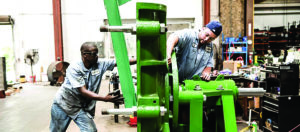
Workers build a slurry pump at Schurco Slurry’s Jacksonville, Florida-based facilities.
Slurry pumps are the heavyweight contenders of fluid transfer, with the largest models capable of moving thousands of gallons per hour of water/solids mixtures that can be viscous, abrasive, corrosive — or all of the above. They’re bigger and a step or two slower than their water-pump stablemates, and although “large” is often associated with “expensive,” larger also can mean better. Larger pumps can benefit mine operators in multiple ways. They rotate more slowly, providing longer wear lives, and therefore can extend routine maintenance intervals. Operators can also benefit by needing fewer spare parts on hand, and maintenance staff has less equipment to manage.
However, the fact remains that they’re not cheap to buy and operate, their size can make repairs and relocation more difficult — and there’s nothing on the process-technology radar screen right now that offers wholesale elimination of slurries or the need to transport them efficiently and reliably, so slurry pumps will be part of the mine environment for the foreseeable future.
That doesn’t mean their usage parameters will remain static or new opportunities for enhanced performance won’t emerge. Incremental changes are expected in some aspects of pump operations.
Remote visibility of pumping equipment, as an example, could be a game-changer. Catching a drop in performance early enough could allow maintenance crews to plan a preventive maintenance intervention before catastrophic failure.
Kenny Don, global product manager for FLSmidth’s Krebs pumps, cyclones and valves, can envisage significant improvements in pump maintenance and performance: “The possibilities are endless if you have the right expertise and historic data. As [pump] duty conditions are stabilized from the mine ramp-up phase, we can use advanced programming to predict the life of different components and drive ERP systems to order parts and maintenance activities. This could even include small components such as packing for events such as gland water line plugging. When that happens, the flow will drop significantly, and the system could alert maintenance to check the line and order new packing and a shaft sleeve.”
Building Better Pumps
Potential advances in pump construction materials could also play a role in quicker product development cycles and ultimate pump performance. For example, GIW Industries, a KSB subsidiary that markets a number of popular heavy- and severe-duty slurry pump product lines, commissioned a new R&D foundry to develop and test new materials for pump fabrication. The company said the new metallurgical facility includes a coreless induction melting system with three melting furnaces that can facilitate more efficient alloy development at greater capacity.
“Pump design is always evolving to increase safety, efficiency and wear life,” Kenny Don said. “However, from a hydraulic perspective, there are few possibilities left that can provide incremental improvement. Most companies have turned to improved materials as their main solution, and while we are doing that too, we are also trying to come up with new ideas to automate maintenance and data analysis.”
While there are increasingly more pump models being designed with harder, more abrasive-resistant wear parts and cast-iron pieces, these typically heavy-duty items can be expensive. An alternative to expensive high-chrome iron parts is to treat lighter parts with abrasion-resistant material that reduces the rate of wear on those parts. Periodic inspection enables a user to see if the coatings are nearing the end of their service life, ready for replacement with similarly treated spares.
Seal arrangements and electric motors are also vulnerable to wear or overheating in harsh applications. Thermal protection in the motors and oil baths for the seals are ways to prolong the life of the unit but eventually replacement is necessary. Slurry pump service and parts support from the manufacturers and distributors is critical in the mining industry because the cost of shutdown for emergency removal and replacement of pumps can be extremely high.
This article was adapted from an article that was originally published in the July 2021 edition of Engineering & Mining Journal (E&MJ).

